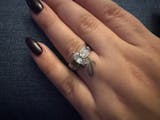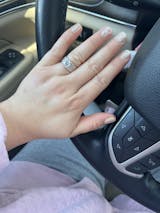Turquoise has been a key element in men's jewelry for thousands of years. From ancient Persian kings to today's collectors, this blue-green stone stands out in rings, necklaces, and cufflinks. While many people connect turquoise with Southwestern and Native American designs, it actually fits well in many modern styles. The stone works in both subtle and bold pieces, making it a practical choice for different occasions. Its natural patterns and colors tell a story of both tradition and modern style.
The Origins and Properties of Turquoise
How Turquoise Forms in Nature
Turquoise forms in dry regions where copper-rich groundwater reacts with minerals in rocks over millions of years. When rainwater seeps through copper deposits, it dissolves copper and aluminum phosphates. These dissolved minerals fill cracks and spaces in surrounding rocks, eventually crystallizing into turquoise. This process typically occurs in arid climates where water moves slowly through rock formations.

Major Mining Locations
The finest turquoise comes from specific regions around the world. Iran's Nishapur mines produce the prized "Persian turquoise," known for its pure, intense blue color. In the American Southwest, Arizona's Sleeping Beauty mine was famous for its light blue stones with minimal matrix patterns. Nevada's mines yield turquoise with distinctive green tones, while New Mexico's Cerrillos mines produce stones with complex spider-web patterns.
Colors and Patterns
Turquoise naturally ranges from sky blue to sea green. Pure blue stones contain more copper, while green variations have higher iron content. The most valued pieces show an even, intense blue color. Many stones also feature dark lines or webs called matrix patterns—these form when the surrounding rock becomes part of the turquoise during its creation.
Factors Affecting Quality
Three main elements determine turquoise quality:
- Color intensity - deeper, more uniform colors are more valuable
- Matrix patterns - some collectors prefer clear stones, while others value distinctive web patterns
- Hardness - harder stones take a better polish and last longer in jewelry
The presence of other minerals during formation affects these qualities. Iron creates greener tones, while aluminum helps form harder stones. The surrounding rock type determines the color and pattern of the matrix.
Turquoise Through Time: From Ancient Treasures to Modern Style
How Ancient Cultures Used Turquoise
Ancient Egyptians valued turquoise as a stone of life and fortune. Pharaohs wore turquoise jewelry and decorated their tombs with it, including King Tut's famous burial mask. Persian culture treated turquoise as a symbol of heaven, using it in palace decorations and royal jewelry. In North America, Native American tribes, especially the Navajo and Zuni, worked turquoise into sophisticated jewelry designs, viewing the stone as sacred and connecting it to the sky and water.

Traditional Protective Powers and Meanings
Different cultures shared similar beliefs about turquoise's protective powers. Persian horsemen attached turquoise to their bridles to protect their horses from falls. Native American warriors believed turquoise arrows would fly straighter. Many cultures saw turquoise as a bridge between earth and sky, believing it brought good fortune and protected against negative energy.
How Men Wear Turquoise Today
Modern men's jewelry has moved beyond traditional Western or Native American styles. Designers now mix turquoise with contemporary materials and settings. Simple silver bands with turquoise inlays work well in professional settings, while larger statement pieces fit casual or artistic styles. The stone appears in everything from minimal cufflinks to bold pendant necklaces.
Types of Turquoise: A Guide to Quality
Natural Turquoise
Natural turquoise comes directly from mines with no treatments. Its color ranges from sky blue to blue-green, with unique matrix patterns formed by the surrounding rock. While pure and valuable, natural turquoise rates only 5-6 on the Mohs hardness scale, making it relatively soft. This softness means it can absorb oils and change color over time. Due to its rarity and pure character, natural turquoise commands the highest prices in the market.
Stabilized Turquoise
Stabilized turquoise makes up about 90% of the market. These stones are treated with clear epoxy resin under high pressure to strengthen them. This process:
- Increases durability to 7-8 on the Mohs scale
- Prevents color changes from exposure
- Maintains the stone's natural appearance
- Makes the stone more affordable
- Protects against cracking and breaking
Reconstituted Turquoise
This type uses turquoise powder mixed with resin to create new stones. While technically real turquoise, it's the most affordable option. The process allows manufacturers to:
- Control color consistency
- Create stronger stones
- Produce larger quantities
- Offer more accessible options
Quality Indicators
The highest quality turquoise shows:
- Rich, uniform blue color without green tints
- Clear matrix patterns that add character without compromising strength
- Smooth, waxy luster when polished
- No chalk-like spots or surface irregularities
- Natural veining that doesn't weaken the stone
The value difference between top-grade and low-grade turquoise can be substantial, with factors like color intensity, pattern quality, and hardness playing key roles in determining worth.
Common Types of Men's Turquoise Jewelry
Rings
Traditional rings feature a central turquoise stone in sterling silver settings. Navajo-style rings often include detailed silver work around an oval or round stone. Band rings incorporate small turquoise inlays between silver sections. Signet-style rings place a flat turquoise stone on top. Large statement rings showcase multiple stones or complex silverwork patterns. Some rings mix turquoise with other stones like coral or onyx.

Bracelets
Cuff bracelets come in several styles:
- Single-stone cuffs with one large turquoise centerpiece
- Multi-stone designs with a row of matched turquoise pieces
- Complex patterns mixing small turquoise stones with silver work
- Wide cuffs featuring turquoise inlay work
Link bracelets connect turquoise stones with silver elements. Beaded bracelets combine turquoise with other materials on elastic or wire cores. Leather wrap bracelets weave turquoise beads into braided leather bands.
Necklaces
Pendant styles include:
- Single polished turquoise stones in silver bezels
- Shield-shaped pieces with traditional silver work
- Cross designs incorporating multiple small stones
- Inlay pendants combining turquoise with other materials
Bead necklaces range from simple single strands to complex graduated designs. Some necklaces alternate turquoise with silver beads or other stones. Traditional squash blossom necklaces feature crescent-shaped silver pendants with turquoise accents.
Cufflinks and Accessories
Formal cufflinks typically use small turquoise cabochons in simple silver settings. Bolo ties feature center slides with turquoise stones. Money clips and tie clips often incorporate small turquoise inlays. Belt buckles range from simple oval designs to elaborate silverwork with multiple stones.
How to Care for Your Turquoise Jewelry
Taking good care of turquoise jewelry helps maintain its color and extends its life. While turquoise is beautiful, it needs proper care to stay in good condition.
Remove Your Jewelry for These Activities
Daily activities can harm your turquoise jewelry. Swimming pools and ocean water contain chemicals that damage the stone. Hand washing, showering, and putting on lotions can leave residue on the stone. During house cleaning or exercise, it's safer to take off your turquoise pieces to protect them from chemicals and sweat.
Clean Your Turquoise Safely
Regular cleaning keeps turquoise jewelry looking its best. A soft, damp cloth works well for basic cleaning. After wiping the stone, dry it right away with a clean cloth. Silver parts can be cleaned with a silver cloth. For deep cleaning, professional jewelers have the right tools and knowledge.
Keep Your Jewelry Away From These Harmful Items
Common items around us can harm turquoise. Chemicals in cleaning products and beauty items can damage the stone. Too much sun can fade the color. Heat and quick temperature changes might crack the stone. Body oils and harsh soaps also affect how turquoise looks over time.
Store Your Turquoise Properly
Good storage habits protect turquoise jewelry. Each piece needs its own soft cloth pouch. A jewelry box with different sections works well to prevent scratches. Silver pieces stay brighter in anti-tarnish bags. The storage area should be cool and dry.
Check Your Jewelry Regularly
Keeping an eye on your jewelry helps spot problems early. The stone settings can get loose with wear. The color might change if the piece is exposed to harmful things. A jeweler should look at valuable pieces once a year to make sure they stay in good shape.
Add Turquoise Jewelry to Your Collection!
Turquoise jewelry combines rich history, natural beauty, and versatile style for modern men. The stone's range of colors and patterns means you can find pieces that match your personal taste, from subtle office-appropriate accessories to bold statement pieces. While high-quality turquoise requires careful selection and proper care, its enduring appeal makes it worth the effort. Whether you choose a traditional Native American design or a contemporary piece, turquoise jewelry adds character to your wardrobe while connecting you to centuries of cultural heritage and craftsmanship.












